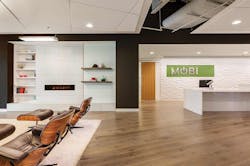When one hears “Fortune 500 company,” it’s not often that the heartland of America comes to mind. For Ashley Fronterhouse Lee and Kathleen Lemaster, partners at Axis Architecture + Interiors in Indianapolis, the Crossroads of America is the perfect location for innovative design. This design duo has collaborated on a variety of interiors, from a redesign for Rolls-Royce in Indianapolis, to tech giant MOBI’s offices (honored with the Economical Design and Best in Show IDEA awards from IIDA) and the 28,000-square-foot Cummins LiveWell Center (which received the 2017 AIA Indianapolis Excellence Award).
For Axis Architecture + Interiors, creating avant-garde interiors starts with having a progressive company mission. Founded in 1995 by Kevin Cooper and Drew White, the two men wanted to create a firm in the Midwest with not only a passion for design but also an understanding that architecture and interior design are equally important to a building.
“Shockingly, I feel that the norm is architecture and interiors don’t really work very harmoniously together,” Lemaster explained. “As an architect, [White] was very involved with interiors and had great insight about exactly how important the two are to one another. Based on that experience, [the combining of the two] was something very natural to him and something he always promoted within our studio. So we work very closely with architects and [they] have a great understanding of interiors.”
Fronterhouse Lee agreed. “Often an architect will design a project then come to a designer for finishes or color selections; that’s never how it’s been here,” she said. “We’re all together from the beginning of a project; we all talk to the client together and create a holistic design.”
This emphasis on design as a holistic practice expands into how Lemaster and Fronterhouse Lee approach inspiration and creativity as a whole. Citing a monthly morning networking event to bring together creative people to discuss topics of interest—a format that is spreading through cities across the country at a grassroots level—Fronterhouse Lee said surrounding herself with designers from a range of fields helps to inspire her work.
Meetups are just a start to how cities are expanding their own creative identities. The old idea of needing to get away to places like New York or Los Angeles to find an artistic oasis has long since passed, with communities embracing various forms of flourishing design. In Indianapolis, Fronterhouse Lee explained, art programs have taken off. “Public art is really important and you can see that throughout the city [with things like] murals painted all over buildings. There’s even a trail that celebrates the different characteristics of our neighborhoods.”
Fronterhouse Lee and Lemaster’s work illustrates the blending of neighborhood and metropolis, architecture and interiors, in addition to artistic communities—whether designing the Cummins LiveWell Center with influences from Apple and Facebook’s headquarters and Alexander Girard or installing an entry wall of colorful Ball canning mason jars for parent company Jarden Home Brands. The results have been met by accolades in the design industry, cementing the Axis Architecture + Interiors team as a go-to for innovative designs with a boutique touch, divorcing the idea of the office as simply a space one occupies for their workday. The revitalized workplace takes the health and wellness of the user into consideration while
creating an independent branding strategy for the company through the use of interior design.
The strength of Fronterhouse Lee and Lemaster’s designs truly appears in their reflection of the human experience, eschewing the latest trends for interiors built with empathy. “You have to be able to empathize with a client and put yourself in their shoes, their situation, their culture,” Fronterhouse Lee said. “As you’re thinking through a design and solving a problem, you’re [seeing] through their eyes and [considering] what could make their life, their experience, that much better. It’s not about incorporating a lot of things that are trendy and having a hodgepodge of different design elements that don’t necessarily make sense; it’s about understanding
the client to develop a flow within the space that is supported by design elements and aesthetic.
“If your space doesn’t feel good, you don’t care about how it looks,” she concluded. “We have to make it feel good first then make sure it looks good too.”
About the Author

Kadie Yale
Former Editor-in-Chief
Kadie Yale holds a BA in Industrial Design from San Francisco State University and a MA in Decorative Art History and Theory from Parsons the New School. In her role as editor-in-chief from 2015-2018, she led the interiors+sources team in creating relevant content that touches on sustainability, universal design, science, and the role of design in society.
